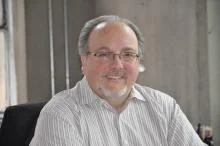An interview with Marc Malizia, CTO of managed cloud company RKON Technologies.
The Enterprisers Project (TEP): Building the platform that will support your company's entire product is a very big undertaking. How did you approach it?
Malizia: Our goal was to create and leverage an

infrastructure which could be utilized to host customer's IT environments in a cost effective and flexible manner and enable us to control the hardware environment for our managed service offering. We knew no other managed service provider was using an IaaS platform as their internal infrastructure at the time. Our big-name competitors were building a dedicated and expensive environment for each of their customers. That strategy led to high cost with little scalability and almost no flexibility to meet customers' growing demands. Fortunately for us, we have a talented team of consultants that I leverage for technical expertise. I also know the market and products, so we created a team of top-notch manufacturers to help us with design.
TEP: How long did the project take?
Malizia: About eight months, from start to finish. We started with high-level design criteria in January 2012 and were finished testing the environment in August of that year. We had to balance this project with our day-to-day customer responsibilities.
TEP: How often did you interact with RKON's other leaders to make sure what you were creating best fit customers' needs?
Malizia: Our director of operations and internal consultants met weekly to provide progress reports, and identify roadblocks and selections. Other executive leaders were briefed every two weeks on progress and capabilities. There wasn't a need to meet more often to ensure we were meeting our customers' needs, as those requirements were the driving force behind our initiative and were mapped out at the start of the project. The team involved in that initial stage consisted of department heads across all points of customer interaction including sales, support, professional and managed services.
Our managed service team was involved in product selection and implementation so they were onboard all the way through the process, which alleviated the need for after-the-fact cross training. The people who helped build this environment were the same as the people who were going to be supporting it.
TEP: How has the platform evolved over the years since you created it?
Malizia: Our initial platform was put in around 2006 and we have evolved three times since. Our original implementation was based on a 1GB network backbone with a Fiber Channel SAN based offering. We backed up to tape for off-site storage. Our recent incarnation uses a 10GB backbone, a SAN with SAS, SATA, Flash cache and SDD. Our server platform now uses 10GB connectivity and we can fit four servers in the same space. As always, everything is built highly available and redundant. We now backup to disk-based solution. Rather than using tapes we now replicate our backups to our secondary center, which also hosts our new disaster recovery capabilities.
We update our technology quite often. We are driven by getting better performance for our customers and when we identify a technology that can do that, we are not afraid to move forward. Through our analysis, we have determined that not only is there a ROI on implementing newer, better and faster, but it also keeps our customer satisfaction high and reduces our labor cost to maintain an aging or over-subscribed environment. Some would call us crazy for constantly putting in the newest technology but we feel it makes perfect business sense.
TEP: Were there any things you wished you'd done differently? Things you did that worked particularly well?
Malizia: Well, I think we did a pretty good job, but there are always things you could have done differently. For instance I feel we should not have implemented a Fiber Channel SAN in our first iteration. Though that was the standard at the time, we have never had trouble with the iSCSI [Internet Small Computer System Interface] implementation we migrated to in overhaul two and three. Also, we would have probably hired a DevOps person a long time ago to help integrate management tools and platforms and provide a more seamless customer experience.
What worked best was the concept of providing our customers with a flexible scalable IaaS type environment they could leverage for their hosting and managed service needs. That was a market differentiator that is just now becoming commonplace.
TEP: What advice would you pass along to other CIOs or CTOs when designing and building platforms for their companies, especially if those platforms will deliver the company's product?
Malizia: Don't be afraid to look at disruptive technologies if they fill a business need or can give you a competitive advantage. Rather than trying to get five years out of your hardware to gain full depreciation, explore the gains your company and your clients will achieve if you implement on a three-year cycle to take advantage of technology advances.
Also, leverage your market experience and listen when talking with your customers. The knowledge you have of the industry, combined with these conversations, will help you determine your customers' needs, even if they are not directly telling you what those are. Lastly, involve your internal team so there is buy-in on the product selection as well as knowledge during the implementation, which will translate into a better supported production environment.
Marc Malizia is co-founder and CTO of RKON Technologies, responsible for the company’s overall technical vision and strategy. Since he helped start the company in 1998, Malizia has played a key role in creating many of RKON Technologies’ products and professional service offerings, as well as building the company’s internal computing platform, which serves as the basis of the brand’s cloud and managed services portfolio. Prior to RKON Technologies, Malizia was director of engineering at LAN Systems. He was also responsible for launching a professional services practice at WorkGroup Productivity. Malizia holds a bachelor’s degree in computer science and mathematics from University of Illinois and a master’s degree in telecommunications from DePaul University.




